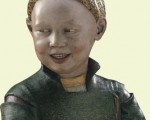
On this day in history events for 27th June to 3rd July.
[Read More...]
Interested in the life and reign of Edward VI, the boy king? This magazine is just for you. Also has an exclusive article about artist Levina Teerlinc.
[Read More...]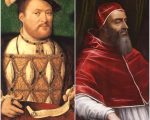
On Friday 24th June 2016 the majority of British people voted to leave the European Union and this had been compared by some newspapers to Henry VIII’s Break with Rome. So, here you go, a Break with Rome quiz! Have fun and good luck!
[Read More...]
In this week’s Claire Chats, I talk about something we’ll be adding to the site in September, and, yes, I am going to be working hard in July and August!
[Read More...]
Here in my area of rural Spain, the feast of St John, or San Juan as he is called here, is a special time. People gather on the night of 23rd at our local natural thermal pool and at midnight they all jump in (or get pushed in!). Like the baptisms that John the Baptist did, this is seen as symbolising the washing away of sins. Then, sardines are cooked on open fires. In coastal areas, sardines are cooked on bonfires on the beach, people jump over the fires for luck and then run into the sea at midnight.
[Read More...]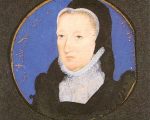
Today marks the 440th anniversary of the death of Levina Teerlinc, painter and miniaturist, at Stepney. Originally from Bruges, Teerlinc, who was the daughter of Simon Benninck, a master illuminator, travelled to England in the 1540s. Teerlinc was court painter to Edward VI, Mary I and Elizabeth I, and produced many paintings and miniatures.
[Read More...]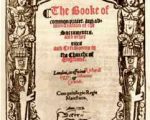
On this day in history, 22nd June 1559, Queen Elizabeth I’s Prayer Book was issued. This version of the Book of Common Prayer “was a conservative revision of the 1552 edition, with the effect of making it somewhat less “Protestant”.”
[Read More...]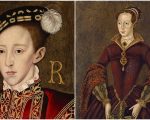
On 21st June 1553, letters patent were issued stating that King Edward VI’s heir was Lady Jane Grey, eldest daughter of the king’s cousin, Frances Brandon, Duchess of Suffolk.
Edward VI was dying, having been ill for a few months, and in the original draft of his “Devise for the Succession” he stipulated that the Crown would descend through the male heirs of Frances, Duchess of Suffolk, if Edward died childless. The problem was that there were no male heirs yet, so when Edward made a turn for the worse he decided to change the document to read: “To the Lady Fraunceses heirs males, if she have any such issue before my death to the Lady Jane and her heirs males.”
[Read More...]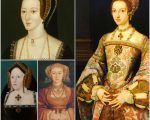
Henry VIII’s six wives are as popular as ever. In the 2016 History Hot 100 recently compiled by BBC History Magazine, no less than four of the notorious Tudor king’s consorts featured. Perhaps, unsurprisingly, wife number two Anne Boleyn finished highest, at number 4. Katherine Parr came in at number 31, Katherine of Aragon at 36, and Anne of Cleves at 38.
Tudormania, as coined by a Guardian article, is pervasive. The general public and historians alike cannot get enough of the Tudors. But our obsession with this colourful dynasty, by and large, centres on a handful of characters that dominate films, novels and articles. This confinement of our focus is starkly revealed in the Hot 100: the top Tudor figures are, unsurprisingly, Elizabeth I, Henry VIII, Anne Boleyn and Thomas Cromwell.
[Read More...]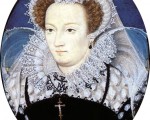

Here’s the valuable transcript from our live chat with Conor Byrne. This was an amazing evening, and we’ve captured it all for you…
[Read More...]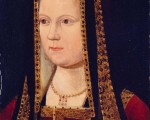
How much do you know about the consorts of Plantagenet and Tudor kings and queens? Test your knowledge with this fun quiz.
[Read More...]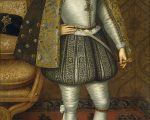
19th June 2016 marks the 450th birthday of King James I and VI of England and Scotland. Unification between the two countries, though at times strained, was brought about by James ascending the throne of England in 1603. The unification was the result of one hundred years of Tudor politics.
Back in 1503, Henry VII arranged for his eldest daughter, Margaret Tudor, to marry James IV of Scotland. Margaret during the course of the marriage gave birth to the future James V in 1512. Fighting between Scotland and England resumed. In 1523, Henry VIII attempted to unite the thrones of Scotland and England by offering his daughter, Princess Mary, as a bride for James V. This proposal was rejected. Moving forward several years, James V married the French Mary of Guise in 1538. Henry VIII had lost his third wife in October 1537 and was seeking a new bride. James V beat his uncle, Henry VIII, who was also trying to marry Mary of Guise. In 1541, James V’s mother and Henry VIII’s sister, Margaret Tudor, passed away; this effectively ended the nearly thirty-year truce between Scotland and England. A war broke out, which saw the death of James V due to illness and depression of the current state of war in December 1542.
[Read More...]
Following on from last week’s video on haircare in medieval and Tudor times, today I’m talking about how Tudor people kept their faces and bodies clean.
[Read More...]
On this day in history, 17th June 1567, Mary, Queen of Scots, was imprisoned at Loch Leven Castle following her surrender to the Protestant nobles at the Battle of Carberry Hill on 15th June.
[Read More...]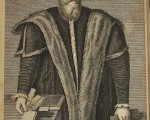
Today is the anniversary of the birth of Sir John Cheke, the English classical scholar and statesman. He was born on 16th June 1514 and was the son of Peter Cheke, bedel of the University of Cambridge. Sir John Cheke was educated at St John’s College, Cambridge, and became a fellow of the college in 1529. He became the first Regius Professor of Greek at the university in 1540 and taught William Cecil, Baron Burghley, and Roger Ascham, the English scholar and Princess Elizabeth’s tutor.
[Read More...]
By 15 June 1567, twenty-four-year-old Mary Stuart had been Queen of Scotland for almost her entire life; never knew her father, James V, because he died when she was six days old; was Queen Consort, then Queen, of France for less than seventeen months; had lost her mother in July 1560; was about to celebrate her son and heir’s first birthday on 19 June, and was married to her third husband. Mary’s first husband, King Francis II of France, died three days before Mary’s eighteenth birthday in 1560. Mary’s mother was dead for roughly five months when her first husband died. She married her second husband, Henry Stuart, Lord Darnley, when she was twenty-two. Mary gave birth to her only surviving child, James VI, during her marriage to Darnley. Darnley died, likely murdered, less than two years after the marriage, and Mary married her third husband, James Hepburn, 4th Earl of Bothwell. Bothwell may have had a hand in the death of Mary’s second husband and there is speculation as to whether Mary indeed wanted to marry Bothwell or whether she was coerced into the marriage.
[Read More...]
This will be a nice, easy quiz for those of you who watched Claire’s video on Tudor haircare on Friday.
[Read More...]
The four weeks of Advent began on Advent Sunday, the fourth Sunday before the Nativity, and was a time of fasting, i.e. abstaining from meat. Christmas Eve was even stricter than the rest of advent, with no meat, cheese or eggs being eaten, until after midnight mass when it was officially Christmas Day.
[Read More...]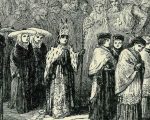
The 6th December was and is the feast of St Nicholas, or St Nicholas of Myra, the 4th century Bishop of Myra (modern-day Demre in Turkey), who is the patron saint of children, as well as sailors, merchants, archers, repentant thieves, brewers, pawnbrokers and students. In medieval and Tudor times, it was traditional for a choirboy to be chosen on 6th December or Childermas (Holy Innocents’ Day) as “Boy Bishop” to act as bishop and to lead processions around communities, collecting money for the church and parish funds, and to lead some religious services.
[Read More...]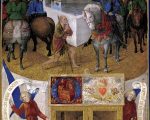
All Saints Day was the celebrated on 1st November every year. It was a feast day in honour of all the saints and martyrs and was established because there were not enough days in the year to commemorate the lives of all the saints. Pope Urban IV said of it: “Any negligence, omission and irreverence committed in the celebration of the saints’ feasts throughout the year is to be atoned for by the faithful, and thus due honor may still be offered these saints.”
[Read More...]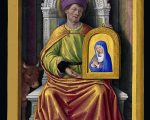
In the medieval period, wakes were held to mark the end of summer and to dedicate the local church. The feasting and partying could go on for days, so, in 1532, Henry VIII stamped down on this practice and ordered that the first Sunday in October was the day for local parish churches to hold their dedication service.
[Read More...]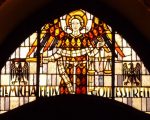
The festival of ‘harvest home’ or ‘ingathering’ was, and still is, celebrated when the harvest was safely done. It was a thanksgiving for God’s help with the harvest and for the crop. It was essential to get the wheat and barley in before the autumn rains and cooler weather, otherwise the community could face starvation – wheat was needed for bread and barley was needed for ale. Professor Ronald Hutton explained the importance of the harvest in the TV series “Tudor Monastery Farm”. He explained that Bloody Flux, a disease common in the Tudor period, was actually caused by malnutrition because when the body was completely famished it suffered an intestinal haemorrhage. Famine was what happened when there was a bad harvest so people celebrated a good harvest and gave thanks for their farming success.
[Read More...]
This was an ancient Celtic festival and marked the start of the wheat harvest. After the first crops were safely brought in, the first loaves baked with the wheat from this harvest in each household would be taken to church and blessed as a thanksgiving for the harvest. This would be followed by a celebratory feast.
[Read More...]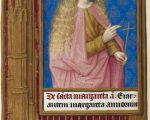
The Visitation of the Virgin was a feast day commemorating the pregnant Virgin Mary visiting her cousin Elizabeth, who was pregnant with John the Baptist. This visit was recorded in the Book of Luke and Luke records how the baby in Elizabeth’s womb “leaped” when Elizabeth heard Mary’s greeting and that “Elizabeth herself was filled with the Holy Ghost; so that she cried out with a loud voice, Blessed art thou among women, and blessed is the fruit of thy womb.”
[Read More...]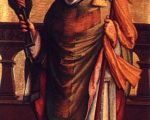
This feast day commemorates the martyrdom of St Erasmus/St Elmo of Formia, Bishop of Formium in Italy. He was tortured and executed for being a Christian in the year 303. He is vemerated as one of the Fourteen Holy Helpers, saints whose intercession is believed to be particularly effective against disease.
[Read More...]
Rogationtide (from the Latin rogare: ‘to ask or beseech’) is the three days leading up to the Feast of the Ascension, which is celebrated forty days after Easter Sunday and which commemorates the Ascension of Christ into Heaven. It is celebrated on the fortieth day after Easter because of what it says in Acts 1 verse 3:
[Read More...]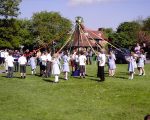
1 May, or May Day, was seen as the first day of summer and had its roots in ancient celebrations of fertility. It was celebrated with special processions, plays and pantomimes, pageants, Morris dancing and the crowning of a May Queen. There would also be a Maypole, a tall wooden pole decorated with greenery and flowers and hung with ribbons. People would hold the ribbons and dance around the Maypole weaving the ribbons together in patterns.
[Read More...]